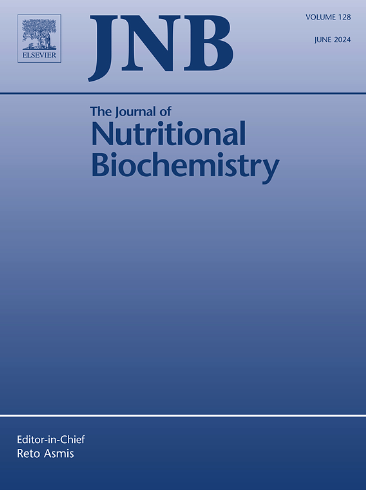对 EVOO 和羟基酪醇在大鼠模型中抗糖尿病功效的体内和硅学洞察。
IF 4.8
2区 医学
Q1 BIOCHEMISTRY & MOLECULAR BIOLOGY
引用次数: 0
摘要
特级初榨橄榄油(EVOO)具有抗糖尿病活性,这主要归功于其多酚羟基酪醇。在这项研究中,我们探讨了特级初榨橄榄油和羟基酪醇对模拟 T2D 大鼠模型的体内抗糖尿病作用,并进行了硅学研究。Wistar 大鼠分为四组。第一组为正常对照组(NC),其余各组均采用高脂饮食(HFD)诱导 2 型糖尿病(T2D),持续 12 周,然后单剂量注射链脲佐菌素(STZ,30 毫克/千克)。一个糖尿病组仍未接受治疗(DC),而其他两组则接受了为期八周的EVOO(90克/千克食物)(DO)或羟基酪醇(17.3毫克/千克食物)(DH)治疗。DC组表现出已确立的T2D的标志性特征,包括空腹血糖水平升高、糖耐量受损、HOMA-IR升高、胰岛素受体表达广泛下调、氧化应激增加以及β细胞功能受损。与此相反,EVOO 和羟基酪醇可引起抗糖尿病反应,其特点是葡萄糖耐量得到改善,血糖清除率加快。系统分析揭示了其潜在的抗糖尿病机制:这两种疗法都能增强肝脏和骨骼肌中胰岛素受体的表达,提高脂肪连素水平,减轻氧化应激。此外,EVOO 减少了细胞内脂类,而羟基酪醇则恢复了脂肪组织的胰岛素敏感性,并提高了 β 细胞的存活率。分子对接和动力学证实了羟基酪醇与 PGC-1α、IRE-1α 和 PPAR-γ(尤其是 IRE-1α)的高亲和力结合,突显了其调节糖尿病信号通路的潜力。总之,这些机制凸显了EVOO和羟基酪醇可能具有的抗糖尿病作用。此外,羟基酪醇与 PGC-1α、IRE-1α 和 PPAR-γ 的良好对接得分支持了其抗糖尿病的潜力,并为进一步研究和开发新型抗糖尿病疗法提供了前景广阔的途径。本文章由计算机程序翻译,如有差异,请以英文原文为准。
In vivo and in silico insights into the antidiabetic efficacy of EVOO and hydroxytyrosol in a rat model
Extra virgin olive oil (EVOO) has a putative antidiabetic activity mostly attributed to its polyphenol Hydroxytyrosol. In this study, we explored the antidiabetic effects of EVOO and Hydroxytyrosol on an in vivo T2D-simulated rat model as well as in in silico study. Wistar rats were divided into four groups. The first group served as a normal control (NC), while type 2 diabetes (T2D) was induced in the remaining groups using a high-fat diet (HFD) for 12 weeks followed by a single dose of streptozotocin (STZ, 30 mg/kg). One diabetic group remained untreated (DC), while the other two groups received an 8-week treatment with either EVOO (90 g/kg of the diet) (DO) or Hydroxytyrosol (17.3 mg/kg of the diet) (DH). The DC group exhibited hallmark features of established T2D, including elevated fasting blood glucose levels, impaired glucose tolerance, increased HOMA-IR, widespread downregulation of insulin receptor expression, heightened oxidative stress, and impaired β-cell function. In contrast, treatments with EVOO and Hydroxytyrosol elicited an antidiabetic response, characterized by improved glucose tolerance, as indicated by accelerated blood glucose clearance. Systematic analysis revealed the underlying antidiabetic mechanisms: both treatments enhanced insulin receptor expression in the liver and skeletal muscles, increased adiponectin levels, and mitigated oxidative stress. Moreover, while EVOO reduced intramyocellular lipids, Hydroxytyrosol restored adipose tissue insulin sensitivity and enhanced β-cell survival. Molecular docking and dynamics confirm Hydroxytyrosol's high affinity binding to PGC-1α, IRE-1α, and PPAR-γ, particularly IRE-1α, highlighting its potential to modulate diabetic signaling pathways. Collectively, these mechanisms highlight the putative antidiabetic role of EVOO and Hydroxytyrosol. Moreover, the favorable docking scores of Hydroxytyrosol with PGC-1α, IRE-1α, and PPAR-γ support the antidiabetic potential and offer promising avenues for further research and the development of novel antidiabetic therapies.
求助全文
通过发布文献求助,成功后即可免费获取论文全文。
去求助
来源期刊

Journal of Nutritional Biochemistry
医学-生化与分子生物学
CiteScore
9.50
自引率
3.60%
发文量
237
审稿时长
68 days
期刊介绍:
Devoted to advancements in nutritional sciences, The Journal of Nutritional Biochemistry presents experimental nutrition research as it relates to: biochemistry, molecular biology, toxicology, or physiology.
Rigorous reviews by an international editorial board of distinguished scientists ensure publication of the most current and key research being conducted in nutrition at the cellular, animal and human level. In addition to its monthly features of critical reviews and research articles, The Journal of Nutritional Biochemistry also periodically publishes emerging issues, experimental methods, and other types of articles.
 求助内容:
求助内容: 应助结果提醒方式:
应助结果提醒方式:


